Christmas is definitely a time for concerts. When I looked on the internet at the various venues offered plus the wonderful buildings they were in I felt I was getting a double whammy! Two for the price of one! Sightseeing in the nicest possible way!
As is often the case, we had some trouble choosing. Why? The selection is huge. Besides musical concerts, there were ballets, operas. . . and priced from expensive down to affordable. We decided to do three over the holidays. Two in the afternoons which are somewhat cheaper, and splurge on one “biggie”.
Our first one was at the National Museum on Wenceslas Square. We had heard this museum was a “must see” because it was so beautiful inside. This particular concert was held in the lobby and was billed as Carols and Christmas Songs plus arias from light operas such as The Marriage of Figaro, The Barber of Seville and Don Giovanni. Most Christmas Concerts have some variation of Ave Maria which I love.
Before going, we did some research regarding the Museum as a building. Built in 1818, as a museum, it now houses over 14 million objects. (Not all in this building, the museum has 10 other buildings). During WW II it took a hit from a bomb but not much was destroyed. In 1968 the main facade was severely damaged by Soviet machine-gun and automatic submachine-gun fire. The shots made holes in the pillars. Despite the repairs made between 1970 – 1972 the damage still can be seen because the builders purposely used lighter sandstone to repair the bullet holes.
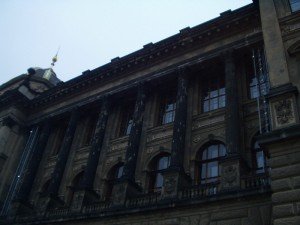
That is the history and rather dreary part. Once we entered the building it was instantly transformed into magnificence! The lobby, where the concert was to be held, was in the center of the building where four staircases meet. The landing was the stage, complete with a big grand piano! There were chairs for people to sit on, as well as seating on the lush red carpeting on the stairs. 

Here we see Soprano Liana Sass and Tenor Vladimir Koval singing one of their arias. They were lively and funny and interacted with the audience. During one scene, Liana flirted with the man you see in the blue shirt and Koval kissed an older lady during his part of the act. They brought the audience right into their songs and actions with a sly wink of the eye and smiles freely given. Most of the Christmas songs were a bit more serious.
Having just arrived in Prague, neither of us had much time yet to practice our Czech. I noticed the lady sitting next to me was really enjoying the music, so much so, that at one point she had tears in her eyes. When it was finished, I turned to her and in English explained that I also had felt very moved. She understood, rattled away in Czech, held my hand and in parting planted a kiss on my cheek! Language was no barrier. . . music and song breached it.
Our second Concert was held in Old Town in the Baroque Library Hall of the former St. Michael’s Monastery. This Monastery was founded in 1626 but has not been a church since the 1800’s. Unfortunately many beautiful objects were sold and the building was in disuse and disrepair. At one time it was even a warehouse! It has recently been turned into a music hall with a beautiful and unique fresco-ed ceiling (at least in my opinion). This concert was a mixture of Czech Christmas Carols and other World Carols. Also on the venue was music from Swan Lake, The Four Seasons and music by the Czech composer, Smetana. We were warmly greeted at the door with champagne and since the gathering was small it almost had the feel of a private concert just for us! No pictures were allowed, but I managed one of the ceiling fresco.
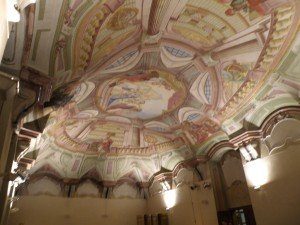

This view was out the window. . this was once an old courtyard, which now is the entrance to Mike’s Cafeteria, appropriately named after St. Michael’s! Maybe the friars from the monastery drank beer here? Ha, ha. Notice the Christmas lights and Santa by the Christmas Tree all made more beautiful by a light dusting of snow.
Our third and last concert was in February. It was at the Municipal House on Republic Square. This building was built in a magnificent Art Nouveau style and since the very beginning was meant to be a multi-functional building. Our concert was held in the large Smetana Hall. I had walked past this building many times and taken photos of the outside but never did I ever get a full shot.
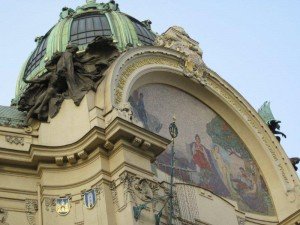
Entering the building I felt very posh and once seated in the Hall and looking around, I truly appreciated it’s beauty. Unfortunately I did not enjoy the music of this concert very much, finding it too heavy for my taste. (To this day, I cannot remember the name of it.) I spent a great deal of time craning my neck to see all the ornamentation and wall paintings by some very famous artists. It boggled my mind just thinking of all the music played in this hall over the years.

Smetana Hall holds a lot of people! The singers took the top half and stood for the entire concert, only singing for about the last 10 minutes! The symphony sat below on the stage.

I strongly encourage people to be sure to go to concerts while in Prague. It is truly a city of music. Everywhere you go, any day of the week, any hour of the day, there seems to be a concert, an opera or ballet to go to. It is a common sight to see musicians carrying their instruments, getting off and on trams and metro. Living over us in our apartment was a man who played for the Prague Symphony and we would quite often hear him practicing his trumpet. That might sound rather annoying, but believe me it wasn’t! It only added to the flavour of Prague!



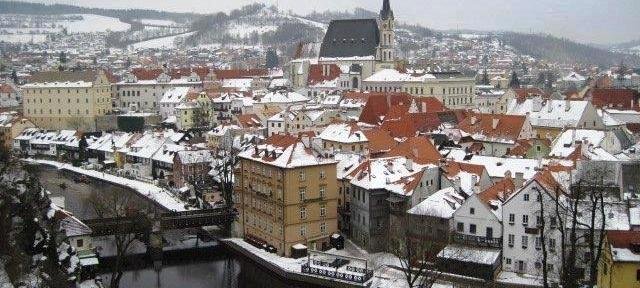














 Jan Palach is a Czech hero. In January 1969, during communism, he was a young University student. Frustrated at the world and the demeaning of life during that time, he set himself afire (self- immolation) to make a political statement. We found his burial site in Olsanske and joined others in leaving flowers commemorating the day of his death. As a mother, I wondered how painful it must have been for his mother and family.
Jan Palach is a Czech hero. In January 1969, during communism, he was a young University student. Frustrated at the world and the demeaning of life during that time, he set himself afire (self- immolation) to make a political statement. We found his burial site in Olsanske and joined others in leaving flowers commemorating the day of his death. As a mother, I wondered how painful it must have been for his mother and family.




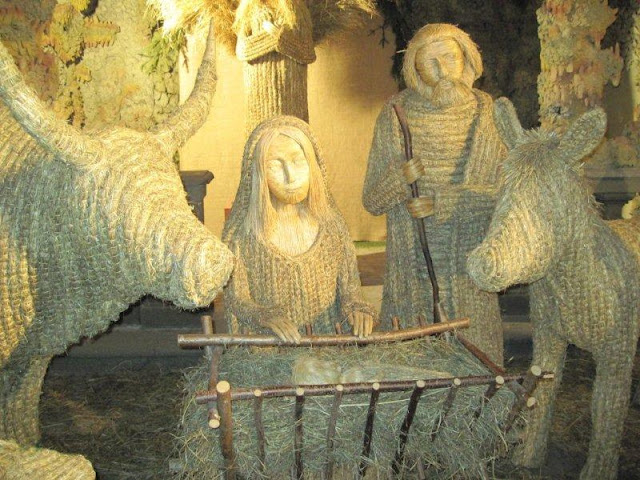 We went during the Christmas holidays so they were exhibiting many different Nativity Scenes over the ages. This one was life size and made from straw. Others were of wood and one was entirely made from wax!
We went during the Christmas holidays so they were exhibiting many different Nativity Scenes over the ages. This one was life size and made from straw. Others were of wood and one was entirely made from wax!